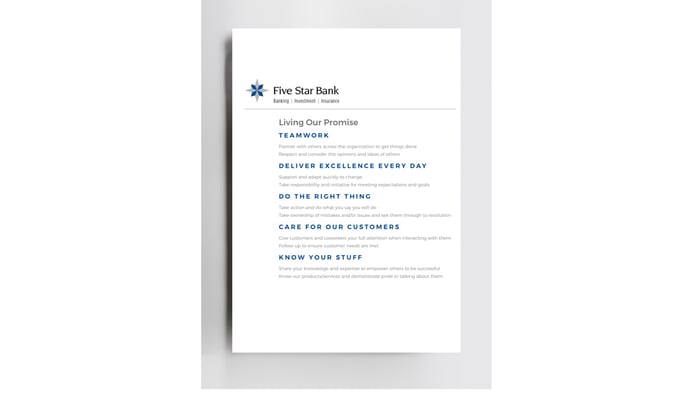
7 min read
Employee retention is an important consideration for employers in all industries. Frequent turnover within an organization is both costly and disruptive to workers and their clients.
The finance industry is one of the world’s largest markets. According to recent reports, the market cap of the global banking sector was $7.7 trillion in the first quarter of 2019. It’s a highly competitive space where the costs and issues around attracting, engaging and retaining key employees can become magnified and too high to ignore.
In 2017, the turnover rate in the financial services industry was up to 27.5%, with 16.2% being attributed to voluntary turnover. As the turnover rate continues to climb, the average tenure continues to drop. And it takes significant time, effort and money to recruit and train proficient employees.
According to Forbes, the cost of an entry-level position turning over is estimated at 50% of that employee’s salary. For mid-level employees, it’s estimated at 125% of salary, and for senior executives, a whopping 200% of salary.
With such high costs in mind, putting in the work to save even a few employees is well worth the effort. Improving retention can help curb that turnover rate, save money, and even boost your company’s morale and productivity.
As you strive to improve employee retention, it is important to consider the specific industry in which you’re operating. The methods that work well for employees at larger financial organizations—such as a corporate bank—may not be as effective at a small credit union. With those dynamics in mind, consider the following methods as you develop your organization’s retention strategy.

Connect your people
It can be easy to lose touch with your team or company employees, especially if you are part of a large organization, with employees spread out across multiple locations. But it is important to create a positive environment that fosters employee engagement, particularly for retention’s sake.
Download our eBook to discover how employee engagement can improve employee retention for finance organizations »
Find opportunities to connect your employees by creating the environment for employee engagement. This will help show that you value their feedback and appreciate all of their hard work. Here are some ideas to get you inspired:
- Host a quarterly or monthly luncheon
- Organize quarterly volunteer opportunities such as community clean-ups
- Ask your teams or departments to conduct regular satisfaction surveys
- Host trivia games with gift cards as the prize
- Give employees the opportunity to get special parking spots

Invest in employee education
As the world of finance continues to evolve and grow, so must the knowledge and skillset of its industry’s employees. As laws and regulations change, it is important for those experts in the field to learn and master its ever-changing climate. This is where on-going education becomes beneficial. Continuing your employees’ education will only further advance and improve their expertise, which will further improve the customer experience and increase productivity.
Here are three ways you can promote continuing education within your organization:
| 1. Offer a clear path for growth to inspire employees to work toward their goals and solidify their future within your company. |
| 2. Create plenty of training opportunities. Make sure you have a training program in place to give your employees the chance to work toward their goals. |
| 3. Allow people to develop mentoring relationships within the organization. |
Focus on inclusive communication
Regardless of industry, communication is an important ingredient for success.
In today’s busy world of high-tech-everything, you may be asking yourself how you can connect employees in the modern workforce. Of course, technology can do most of the hard work for you! A mobile app can help fill in those gaps, connecting peers and their superiors with the simple click of a button.
An employee engagement mobile app is especially useful for:
- Connecting on-the-go, busy consultants or salespeople with limited access to a desktop, particularly those who work from home or abroad.
- Developing a “culture of thanks” that encourages employees.
- Emphasizing the company's mission, values and goals.
- Keeping employees updated with the most recent company news and recognition moments, whether from the airport or train.
- Allowing managers to instantly recognize their teams and peers, and be notified when someone on their team has been recognized.
One of our clients, Suncorp, uses powerful employee communication tools, alongside employee reward and recognition, to unite and engage thousands of employees who are spread across a large portfolio of services and solutions and located in 250 different offices and branches under its new “One Suncorp” business model, purpose, strategic priorities and desired behaviors in the Suncorp Compass.
 With the new program, the organization is able to connect their employees with inclusive communication – from CEO to management to associates – while keeping their values front of mind, and linking everyday achievements to their mission and purpose, in order to improve employee engagement and retention.
With the new program, the organization is able to connect their employees with inclusive communication – from CEO to management to associates – while keeping their values front of mind, and linking everyday achievements to their mission and purpose, in order to improve employee engagement and retention.
Give some recognition
Positive customer feedback is great for any financial or bank workers’ motivation, but it is critical for you, the employer, to communicate positive recognition where it’s due. A pat on the back from a team leader or peer will work wonders in boosting morale and inspiring your staff to continue to work hard and stay loyal to the company.
In fact, one of our clients, Five Star Bank, a publicly-owned financial services provider with over 700 associates across 54 offices, has improved both the employee and customer experience with the help of employee recognition tools.

The values-based recognition platform helped shine a spotlight on desirable behavior, which in turn helped improve employee engagement and employee connections. What’s more, the organization’s Net Promoter Score (NPS) is 2.5x higher than the industry average and continues to improve.
Some easy ways to show recognition include:
| Showing some love on social media: | With the use of an employee communications tool, companies can provide a feed wherein employees may connect with one another by exchanging comments or offering up “likes.” This medium can promote a culture of appreciation and promote a positive work environment. |
| Starting an employee recognition program: | “Shout-out” employees who have helped reach the firm’s goals, demonstrated the organization’s values or went above and beyond to help a customer with an employee recognition program. |
| Giving thanks with a card: | Sending eCards is a simple but effective method of acknowledging employees and promoting interactions among colleagues. |
Recognition and rewards can improve morale among your team or employees, which can positively influence your retention goals. In fact, in a recent study 91% of HR professionals agreed that employee recognition has a positive impact on employee retention.

Recognize and reward key achievements
Recognizing and rewarding employees with service awards for tenure milestones and other industry achievements are a popular option for retention strategies. Many organizations offer compensation bonuses and other awards to employees that pass industry exams or reach the 5, 10 and 15 year employment marks.
As an example, a young analyst passing a CFA exam could be congratulated by a superior with eCard and recognized socially so that key team members can share in the good news.
And while service awards can make employees feel appreciated, they should be a part of a larger recognition strategy that allows for more moments of everyday recognition – so you can truly build a culture of continuous recognition.
We like to reference our recognition pyramid that walks through how to set up your own recognition framework. With this visual and strategic tool, you can identify the layers of recognition at your organization and reach everyone in your business in some way.
Employee retention is crucial in every industry, but it can be particularly challenging within the field of finance. High turnover is harmful for everyone – the employees, the institution and even the clients.
The strategies listed above may help you improve employee satisfaction and retain the workers you value so much, especially if your leaders to set the example for employees. When you engage, recognize, and connect your team, your organization can achieve higher employee retention.

.jpg) Linda Piontek
Linda Piontek



